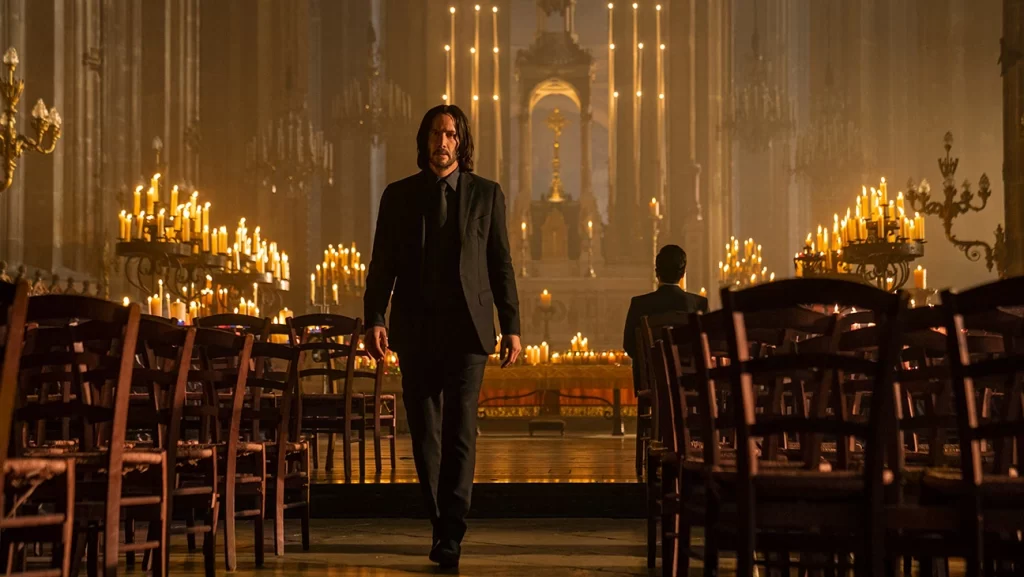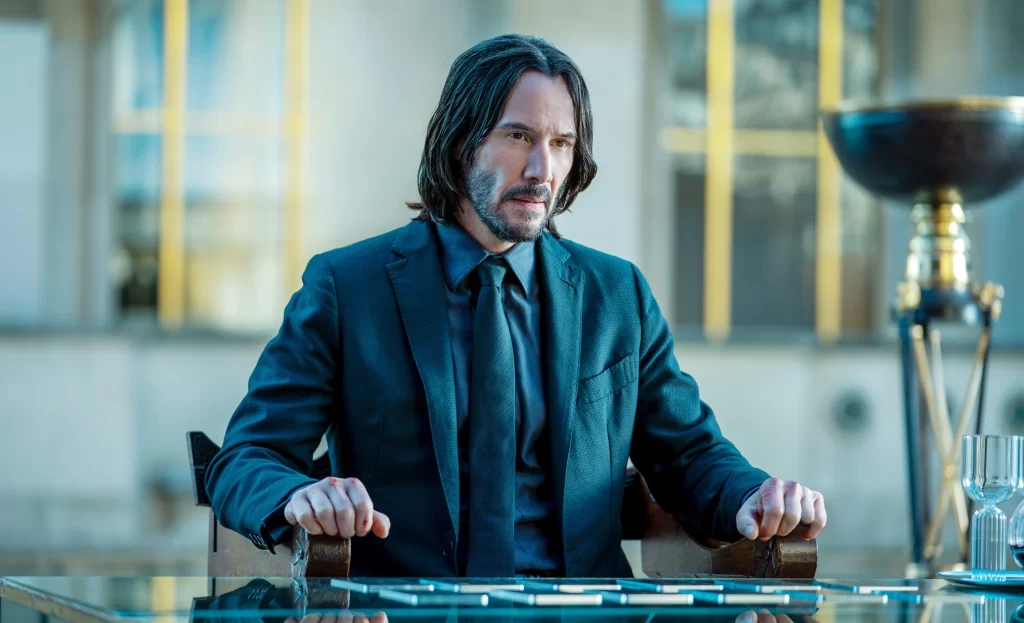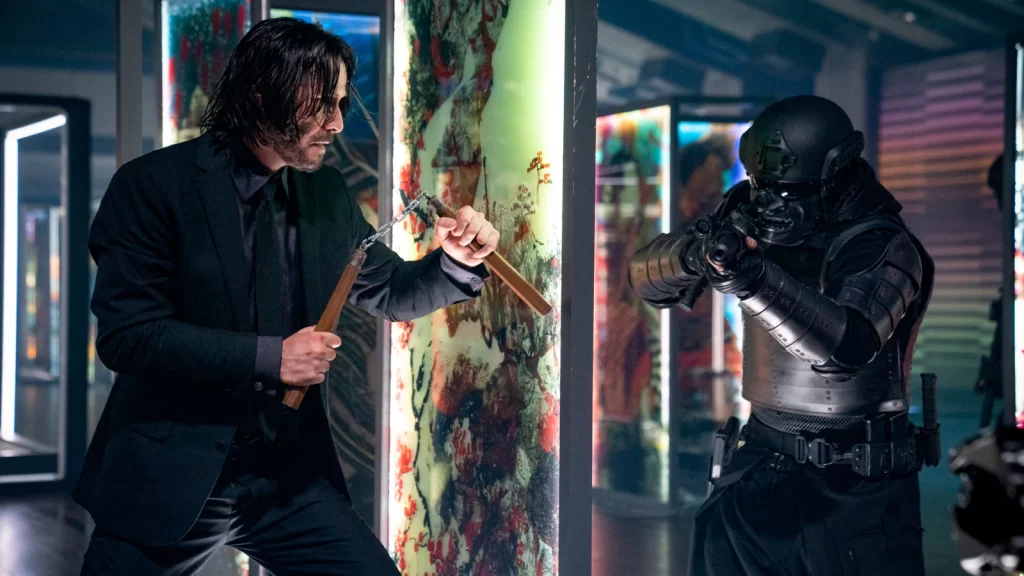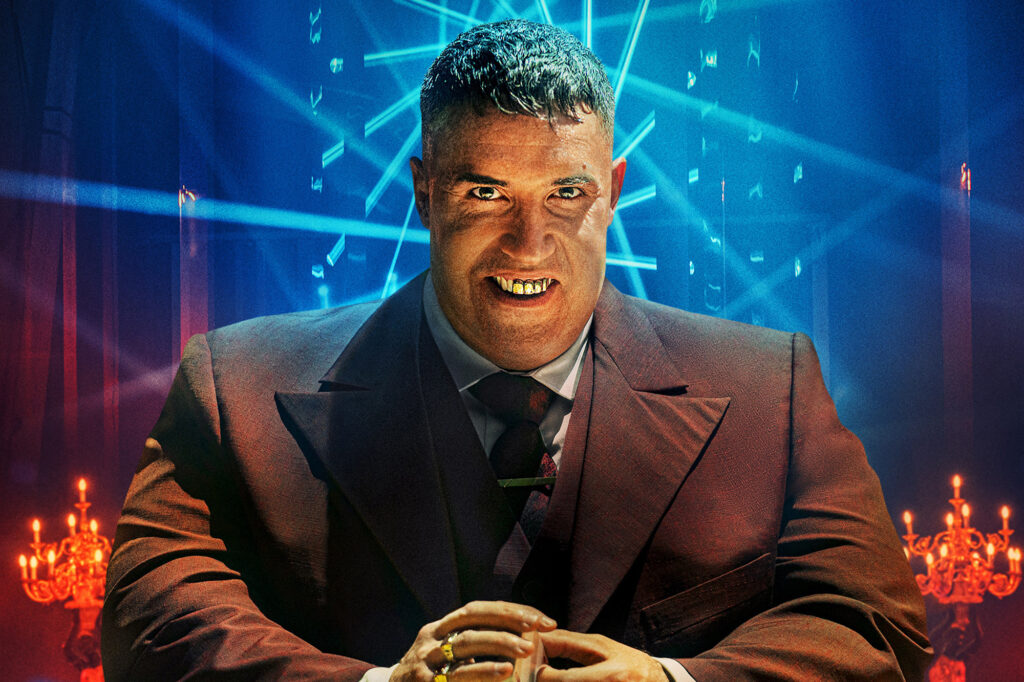
During one of the many, many fight scenes in John Wick: Chapter 4, an antagonist named Caine issues a call for expediency: “Let’s get this shit over with.” I hesitate to quibble with Caine, not least because he’s a deadly assassin played with balletic grace by Donnie Yen, but his directive here isn’t just grouchy; it violates the very spirit of the franchise. The John Wick pictures are creatures of excess and extravagance. Their hero may be a ruthlessly efficient killer, but the movies which sustain him are fueled by elaborate martial artistry and ornate mythology. They don’t get shit over with; they deliver some of the craziest shit imaginable.
Chapter 4, the latest, longest, and (potentially) last installment in the series which began in 2014, capably fulfills the franchise’s extremist imperatives, even as it subtly interrogates them. Or maybe not so subtly. It’s been nine years and four films since a group of Russian thugs killed the wrong guy’s puppy, and the plot hasn’t really changed ever since; John is still angry, still hunted, and still—as played with soulful physicality by Keanu Reeves—meting out retribution via manifold means and gruff precision. The prior episode, the bonkers and gloriously operatic Parabellum, essentially finished where it started, with a bloodied but unbroken John vowing revenge against the sinister cabal known as the High Table. Chapter 4 continues this endless battle—a rather lopsided duel in which one person wages war against what seem to be thousands of expendable henchmen (when someone asks John how many people he needed to kill to reach a certain point, he responds, with characteristic curtness, “A lot”)—but it also contemplates the existential toll that time and death have levied on the bearded man in the bulletproof suit.
John Wick is less a character than a myth, both within his films (others still refer to him as Baba Yaga, or boogeyman) and beyond them. His lethality of purpose is so obsessive and single-minded, it blots out the rest of his personality—a consequence not lost on Chapter 4’s chief villain, a preening bureaucrat gifted with the ridiculous title, “the Marquis Vincent de Gramont” (Bill Skarsgård, doing a silly French accent). During one of their freighted conversations, the Marquis remarks—coldly, but not necessarily inaccurately—that John will never find peace, because he wouldn’t know what to do with it; all he lives for is violence.

Could you say the same thing about his movies? And if you could, would it qualify as an insult or a compliment? Unlike the Mission: Impossible pictures, with their labyrinthine conspiracies, or the Fast & Furious saga, with its sprawling veneration of family, the John Wick franchise isn’t interested in emotional depth or narrative complexity. This isn’t to say it lacks ambition—its increasingly exotic world-building is quite the opposite of lazy—merely that it channels its aspirations in very particular ways. Every ongoing series is cursed with the perpetual obligation to provide more, and these movies feed this compulsory hunger not through more character development or more plot convolutions, but through more moreness: more eye-popping set pieces, more hordes of anonymous foes, more insane physical challenges, more intricate folkloric absurdity. This new episode is no exception. Even as it splices its frenzied kineticism with a pinch of self-awareness, Chapter 4 is the most heightened Wick flick yet.
It takes some time before it scales those metaphorical walls (not to mention literal stairs). If the opening blitzkrieg of Parabellum represented the series’ apex (though I remain partial to Chapter 2 overall), this latest go-round begins at a point of relative sluggishness. Following an extended prologue that’s notable for two things—director Chad Stahelski’s penchant for David Lean-style sunrises (think Lawrence of Arabia, but with speedy horses replacing plodding camels) and the demolition of Ian McShane’s precious New York Continental, the latter of which heralds the sad demise of fan-fave concierge Charon (unavoidably recalling the recent death of the beloved Lance Reddick)—the action shifts to Japan, where John… well, look, he kills a bunch of guys. That, as the Marquis points out, is what John Wick does. The caliber of the movies that bear his name hinges on the imagination of the staging and the alacrity of the choreography.
Chapter 4’s first big sequence—a careening melee that rampages through the kitchens and ballrooms of the Osaka Continental, which is run by John’s loyal friend (Hiroyuki Sanada) and managed by his sharp-eyed daughter (the musician Rina Sawayama, flashing screen presence in her first big-screen role)—exposes the franchise’s lone limitation: There are just too many minions to murder. John’s essential invincibility renders him a fearsome opponent but also a somewhat perfunctory hero; the more goons he obliterates, the more repetitive his exploits grow. It’s been two decades since Reeves walloped countless Hugo Weavings in The Matrix Reloaded’s “burly brawl,” and in a sense, the John Wick films function as an extended variation of that same unbalanced duel.

Nevertheless, even the most familiar fight scenes in Chapter 4 are visually engaging. Stahelski and his crew—in particular cinematographer Dan Laustsen (The Shape of Water) and editor Nathan Orloff—place a healthy premium on spatial lucidity, favoring crisp medium shots and smooth movement rather than the Greengrassian blizzard of shaky-cam, constant-cutting chaos. Stahelski also prioritizes actual stunt work over fanciful CGI, which is why, despite the action’s broader implausibility, the kicks and punches carry tangible weight. Much of this tactility is thanks to Reeves, who remains a lithe combatant in his middle age; here he seems to have developed a pet move, in which he first swings his right arm upward to shoot an enemy rushing toward him and then—like a point guard blessed with ineffable court vision—angles his elbow backward and fires behind him to dispatch a second foe you didn’t even see was there. It’s awesome.
Reeves, of course, does more with his fists and feet than his mouth, but the script’s minimalist dialogue (by Shay Hatten and Michael Finch) shouldn’t diminish the skill of his performance. Many of his lines—“Maybe not,” “I’m going to need a gun,” the immortal “Yeah”—might sound goofy on the page, but he grounds them in rugged sincerity, and his growling gravity remains crucial ballast for such a vertiginously ascendant franchise. If Chapter 4 starts at a relative low point, it quickly climbs up and keeps rising upward, beginning with a gripping clash between John and the blind Caine that whirs with relentless motion but which also—in the first of many inspired touches—throttles down for a moment of suspenseful, exhilarating stillness.

Structurally, the movie operates as a series of quests: John needs to get a thing, which requires him to kill a guy, which means he needs to go to a place, etc. The narrative’s simplicity allows Stahelski to focus on opulence and style, and he delivers not just in terms of vigorous combat but also swoon-worthy colors and images. Shifting the setting from Osaka to Berlin and then Paris, he turns European metropolises into stages of Gothic beauty; the City of Lights in particular becomes a glittering landscape of gorgeously ornamented brutality.
And there is plenty of that. It is difficult to choose the single greatest set piece in John Wick: Chapter 4. The visit to a German nightclub in which a rigged game of five-card draw (lorded over by a delightfully hammy Scott Adkins) transforms into a wild brawl surrounded by throngs of writhing dancers? The fracas in a housing complex where the camera suddenly ascends skyward, floating through the air as John lays waste to overmatched challengers with fluid, de Palma-like exactitude? The impossible journey up a seemingly endless flight of stairs, the clock racing as bullets and blades rain down from above? (About the weapons: John has added nunchucks and grenade launchers to his arsenal, while Caine pays tribute to his adversary by wielding a #2 pencil.)

Naturally, these scenes of majestic mayhem unfold amid a backdrop of ludicrously flamboyant world-building. The John Wick movies are more about action than attitude, but the playful flourishes—like a solemn man dubbed a harbinger (Clancy Brown) showing up at the Continental and brandishing a giant hourglass full of red sand, or a swaggering Laurence Fishburne presenting John with a new suit that’s “the latest in ballistic chic”—add flavor to the carnage. There are also the usual tributes, whether to Greek mythology (a tracker played by Shamier Anderson, who’s of course accompanied by a trusty Belgian Malinois, goes by the name Mr. Nobody), to John Woo’s gun-fu epics, or to American classics like The Warriors; the final act features a radio station which announces location points to bounty hunters while sporting the call sign WUXIA.
Those are fun nods, but this franchise has grown beyond mere pastiche and evolved into its own primary source. In fact, it’s hard to expect much more from it. That’s arguably sacrilegious, given its commitment to continually topping itself. But if episodes 2 and 3 concluded with winking ellipses, Chapter 4 feels like a defiant and definitive exclamation point. This crazy, magnificent series has no stairs left to climb.
Grade: B+
Jeremy Beck is the editor-in-chief of MovieManifesto. He watches more movies and television than he probably should.
